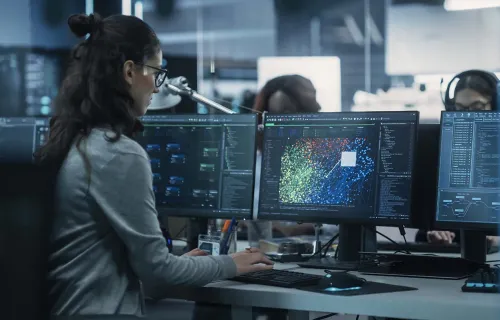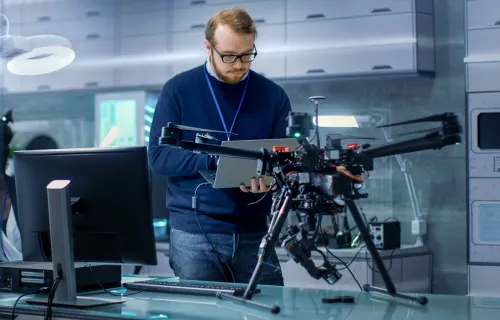It's no secret that artificial intelligence (AI) has become a part of our daily lives. Every day more stories on AI are flooding our newsfeeds. From criticism to hype, the commentary runs the gamut from the enormous potential of AI to transform society to fears about the prospect of machine intelligence that can outperform humans. However, AI's potential to bring change at an increasingly rapid pace is worth talking about, especially for government agencies facing significant gaps in the workforce.
The public's expectations for government interaction and transparency are higher than ever. Residents and government employees alike want experiences that rival what they find in the private sector: a constituent-centric, omnichannel approach that delivers access to services and information tailored for them. AI can help deliver this experience, but it can feel daunting to determine how to incorporate this technology in meaningful ways. With this in mind, let's look at practical applications of AI and how organizations can leverage the technology to do more with less while increasing accuracy and gaining new insights.
AI is an integrated part of our daily lives
While it often conjures up images of a futuristic world ruled by robot overlords, AI has been a part of our lives for decades. The first artificial intelligence program was developed in the 1950s. Still, the exponential increases in computing power and the ability to retain and quickly access huge volumes of data have made AI a practical reality. You've likely been using what can be considered AI for years. Do you look for a chatbot first instead of calling a customer service centre for support? What about utilizing AI when you're driving? As many states now require hands-free operation of cell phones in vehicles, using voice assistants has become commonplace. "Hey, Alexa, play my soundtrack!" Did you know Microsoft Word's predictive text and Google Translate also leverage AI technology? Artificial intelligence, machine learning, and natural language processing have all become mainstays of efficiency in our everyday personal lives, and it's time to embrace these technologies to transform how we work as well.
During my twenty-plus years in state government, we witnessed a gradual reduction in our workforce. In recent years, our staffing challenges have been less about budget constraints and more about the inability to find and attract talent. Nonetheless, the mandates and work continued to grow. The pandemic brought even more demands on government, especially the need to deliver more digital-forward citizen services. When faced with unfilled positions amid an ever-growing workload, the question is "What solutions can organizations leverage to overcome this challenge?" Along one path lies the potential to harness automation and AI.
Embrace technology to achieve more with less
When calls from the public to various agencies exploded at the beginning of the pandemic, we rapidly implemented solutions for contact centres such as virtual agents, intelligent call routing, callback queues, and analytics. Chatbots also offered agencies the capability to provide their constituents with a simple path to answers without scouring the website or trying to connect with a live person. This type of technology allowed agencies the flexibility to implement AI as simply or as sophisticated as they liked. Organizations could utilise basic Q&A functionality or implement a more in-depth experience to allow for constituent-specific inquiries. Implementing this technology provides a better digital experience, around the clock services, and multilingual support for a diverse group of users. For the government, it's a force multiplier, delivering improved constituent service and saving employee time for more critical or complex work.
Another simple and effective approach to leveraging AI is by automating repetitive tasks with robotic process automation (RPA). RPA software mimics human actions to interact with a system or application. Just like we can navigate a system and its various screens, fill in forms, or move files, bots can do the same work faster and with fewer errors. In government, finance departments are prime opportunities for RPA. We can automate account reconciliations, perform two- and three-way invoice matches, generate invoices, flag potential errors or omissions, and many other possibilities. Automating high-volume, standardised transactions can not only free up staff time, but it also increases the accuracy of transactions. Any process that involves repetitive, rules-based activities is a good candidate for RPA.
Utilising data-driven insights and generative AI to drive efficiencies
Government entities have more data than ever and can utilise AI to drive innovation and enable data-driven insights and decision-making. AI technologies can automate reports and leverage analytics to predict trends, analyze variances and flag potential errors or policy violations, including in real-time during data entry to prevent those errors before they happen. Imagine also saving staff time and creating a better user experience through virtual assistants that understand natural language, can quickly return relevant user guides and video tutorials, and even allow review, entry, and approval of transactions right from the chat window. Similarly, a public-facing virtual assistant can help constituents navigate government processes for renewing a license or filing and paying taxes.
Finally, we can't have a conversation on AI without touching on generative AI. Until recently, most AI assisted with efficient usage or better insight into our data. Generative AI delivers the possibility to create net new information or content. It has the potential to transform our lives, however, it also raises ethical, transparency, and data privacy issues that need to be addressed. Many organizations are exploring the possibilities of generative AI with caution. They are utilizing it to jump-start activities such as writing job descriptions, vacancy postings, or solicitations for goods or services. Overall, generative AI has the potential to help government entities save time and work more efficiently.
Explore the future of constituent interaction
The public's expectations for a simple digital user experience will continue to increase even as government workforce challenges remain. This dichotomy makes the legacy model of primarily serving the public in siloed teams at brick-and-mortar locations unsustainable. Government organizations have the imperative and the public desire to enable a modern, digital government. Constituents do not want to figure out which division of an agency they need to find to get the requirements for a business license or apply for a grant or aid. The constituent experience of the future should allow quick and easy online search capabilities and allow residents to log in to access all the services and applications they utilise on a personalised dashboard. AI technologies can even recommend additional services constituents may find of interest. Furthermore, proactive notifications and reminders will round out the constituent digital experience, allowing all government interactions to be conducted virtually if desired.
Many government leaders have confirmed that a modern and simplified constituent experience is high on their priority list. Still, it can be challenging to embark on such initiatives with competing workloads and ongoing workforce shortages. AI-powered technologies such as RPA, chatbots, virtual agents, and analytics can help deliver those goals.
Learn more about how we’re bringing intelligence tools to government operations through our CGI Advantage Intelligence Suite.








